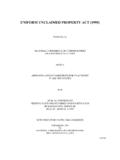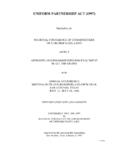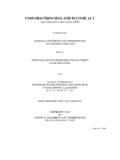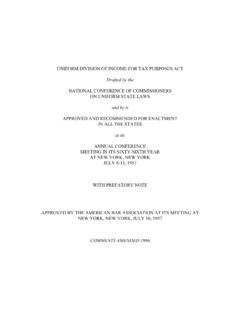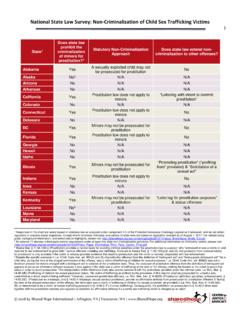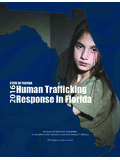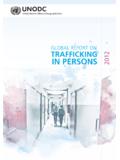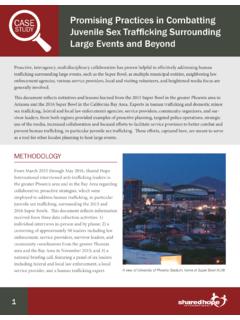Transcription of UNIFORM ACT ON PREVENTION OF AND REMEDIES FOR HUMAN ...
1 UNIFORM ACT ON PREVENTION OF AND REMEDIES FOR HUMAN trafficking * Drafted by the NATIONAL CONFERENCE OF COMMISSIONERS ON UNIFORM STATE LAWS and by it APPROVED AND RECOMMENDED FOR ENACTMENT IN ALL THE STATES at its ANNUAL CONFERENCE MEETING IN ITS ONE-HUNDRED-AND-TWENTY-SECOND YEAR BOSTON, MASSACHUSETTS JULY 6 - JULY 12, 2013 WITHOUT PREFATORY NOTE OR COMMENTS COPYRIGHT 2013 By NATIONAL CONFERENCE OF COMMISSIONERS ON UNIFORM STATE LAWS July 16, 2013 *The following text is subject to revision by the Committee on Style of the National Conference of Commissioners on UNIFORM State UNIFORM ACT ON PREVENTION OF AND REMEDIES FOR HUMAN trafficking ARTICLE I GENERAL PROVISIONS SECTION 1. SHORT TITLE. This [act] may be cited as the UNIFORM Act on PREVENTION of and REMEDIES for HUMAN trafficking .
2 SECTION 2. DEFINITIONS. In this [act]: (1) Adult means an individual 18 years of age or older. (2) Business entity means a person other than an individual. (3) Coercion means: (A) the use or threat of force against, abduction of, serious harm to, or physical restraint of an individual; (B) the use of a plan, pattern, or statement with intent to cause an individual to believe that failure to perform an act will result in the use of force against, abduction of, serious harm to, or physical restraint of an individual; (C) the abuse or threatened abuse of law or legal process; (D) controlling or threatening to control an individual s access to a controlled substance set forth in [insert the appropriate state code sections defining controlled substances]; (E) the destruction of, taking of, or the threat to destroy or take an individual s identification document or other property; (F) use of debt bondage.
3 (G) the use of an individual s physical or mental impairment, where such impairment has substantial adverse effects on the individual's cognitive or volitional functions; 2 or (H) the commission of civil or criminal fraud. (4) Commercial sexual activity means sexual activity for which anything of value is given to, promised to, or received by a person. (5) Debt bondage means inducing an individual to provide: (A) commercial sexual activity in payment toward or satisfaction of a real or purported debt; or (B) labor or services in payment toward or satisfaction of a real or purported debt if: (i) the reasonable value of the labor or services is not applied toward the liquidation of the debt; or (ii) the length of the labor or services is not limited and the nature of the labor or services is not defined.
4 (6) HUMAN trafficking means the commission of any of the offenses created in Sections 3 through 7 of this [act]. (7) Identification document means a passport, driver s license, immigration document, travel document, or other government-issued identification document, including a document issued by a foreign government. (8) Labor or services means activity having economic value. (9) Minor means an individual less than 18 years of age. (10) Person means an individual, estate, business or nonprofit entity, or other legal entity. The term does not include a public corporation, government or governmental subdivision, agency, or instrumentality. 3 (11) Public corporation means an entity that is: (A) owned by a government, or a governmental subdivision, agency, or instrumentality; or (B) created to perform a governmental function or to operate under the control of a government or governmental subdivision, agency, or instrumentality.
5 (12) Serious harm means harm, whether physical or nonphysical, including psychological, economic, or reputational, to an individual which would compel a reasonable individual of the same background and in the same circumstances to perform or continue to perform labor or services or sexual activity to avoid incurring the harm. (13) Sexual activity means [to be defined in each state by cross-referencing existing state statutory provisions or listing specific sexual activity, either or both], or sexually-explicit performances. (14) State means a state of the United States, the District of Columbia, Puerto Rico, the United States Virgin Islands, or any territory or insular possession subject to the jurisdiction of the United States. The term includes an Indian tribe or band recognized by federal law or formally acknowledged by a state.
6 (15) Victim means an individual who is subjected to HUMAN trafficking or to conduct that would have constituted HUMAN trafficking had this [act] been in effect when the conduct occurred, regardless of whether a perpetrator is identified, apprehended, prosecuted, or convicted. Legislative Note: For Section 2(13), states can cite their state laws on prostitution and similar crimes, or name specific sex acts, such as, for example, sexual intercourse, cunnilingus, fellatio, anal intercourse, intrusion by any object into the genital or anal opening of another s body and the stimulation by hand or an object of another individual s genitals or breasts, for the purpose of arousing or gratifying the sexual desire of any individual. 4 ARTICLE II PENALTIES SECTION 3. trafficking AN INDIVIDUAL.
7 (a) A person commits trafficking an individual if the person knowingly recruits, transports, transfers, harbors, receives, provides, obtains, isolates, maintains, or entices an individual in furtherance of: (1) forced labor in violation of Section 4; or (2) sexual servitude in violation of Section 5. (b) trafficking an individual is a [class c felony]. (c) trafficking an individual when the individual is a minor is a [class b felony]. Legislative Note: A state will need to ensure that the offense classifications [class b-d] in this act are modified to correspond with the existing grading and punishment ranges of the state. The three classes of felonies in the act are not intended to unduly restrict legislative discretion in the classification of offenses. SECTION 4.
8 FORCED LABOR. (a) A person commits forced labor if the person knowingly uses coercion to compel an individual to provide labor or services, except where such conduct is permissible under federal law or law of this state other than this [act]. (b) Forced labor is a [class c felony]. (c) Forced labor when the individual is a minor is a [class b felony]. SECTION 5. SEXUAL SERVITUDE. (a) A person commits sexual servitude if the person knowingly: (1) maintains or makes available a minor for the purpose of engaging the minor in commercial sexual activity; or (2) uses coercion or deception to compel an adult to engage in commercial sexual 5 activity. (b) It is not a defense in a prosecution under subsection (a)(1) that the minor consented to engage in commercial sexual activity or that the defendant believed the minor was an adult.
9 (c) Sexual servitude under subsection (a)(1) is a [class b felony]. (d) Sexual servitude under subsection (a)(2) is a [class c felony]. SECTION 6. PATRONIZING A VICTIM OF SEXUAL SERVITUDE. (a) A person commits patronizing a victim of sexual servitude if the person knowingly gives, agrees to give, or offers to give anything of value so that an individual may engage in commercial sexual activity with another individual and the person knows that the other individual is a victim of sexual servitude. (b) Patronizing a victim of sexual servitude is a [class d felony]. (c) Patronizing a victim of sexual servitude who is a minor is a [class c felony]. [SECTION 7. PATRONIZING A MINOR. (a) A person commits patronizing a minor if: (1) with the intent that an individual engage in commercial sexual activity with a minor, the person gives, agrees to give, or offers to give anything of value to a minor or another person so that the individual may engage in commercial sexual activity with a minor; or (2) the person gives, agrees to give, or offers to give anything of value to a minor or another person so that an individual may engage in commercial sexual activity with a minor.]
10 (b) Patronizing a minor under subsection (a)(1) is a [class b felony]. (c) Patronizing a minor under subsection (a)(2) is a [class c felony].] Legislative Note: A majority of states already have statutory provisions addressing the offense of Commercial Sexual Abuse of a Minor or Patronizing a Minor. If a state has a provision comparable to Section 7, a state may indicate that such offense is provided for in [cite relevant state law] and may also cross reference the provision in Section 6. For those that do not, the 6 language in bracketed Section 7 should be inserted. SECTION 8. BUSINESS ENTITY LIABILITY. (a) A business entity may be prosecuted for an offense under this [act] if: (1) the entity knowingly engages in conduct that constitutes HUMAN trafficking ; or (2) an employee or nonemployee agent of the entity engages in conduct that constitutes HUMAN trafficking and the commission of the offense was part of a pattern of illegal activity under this [act] for the benefit of the entity, which the entity knew was occurring and failed to take effective action to stop.

